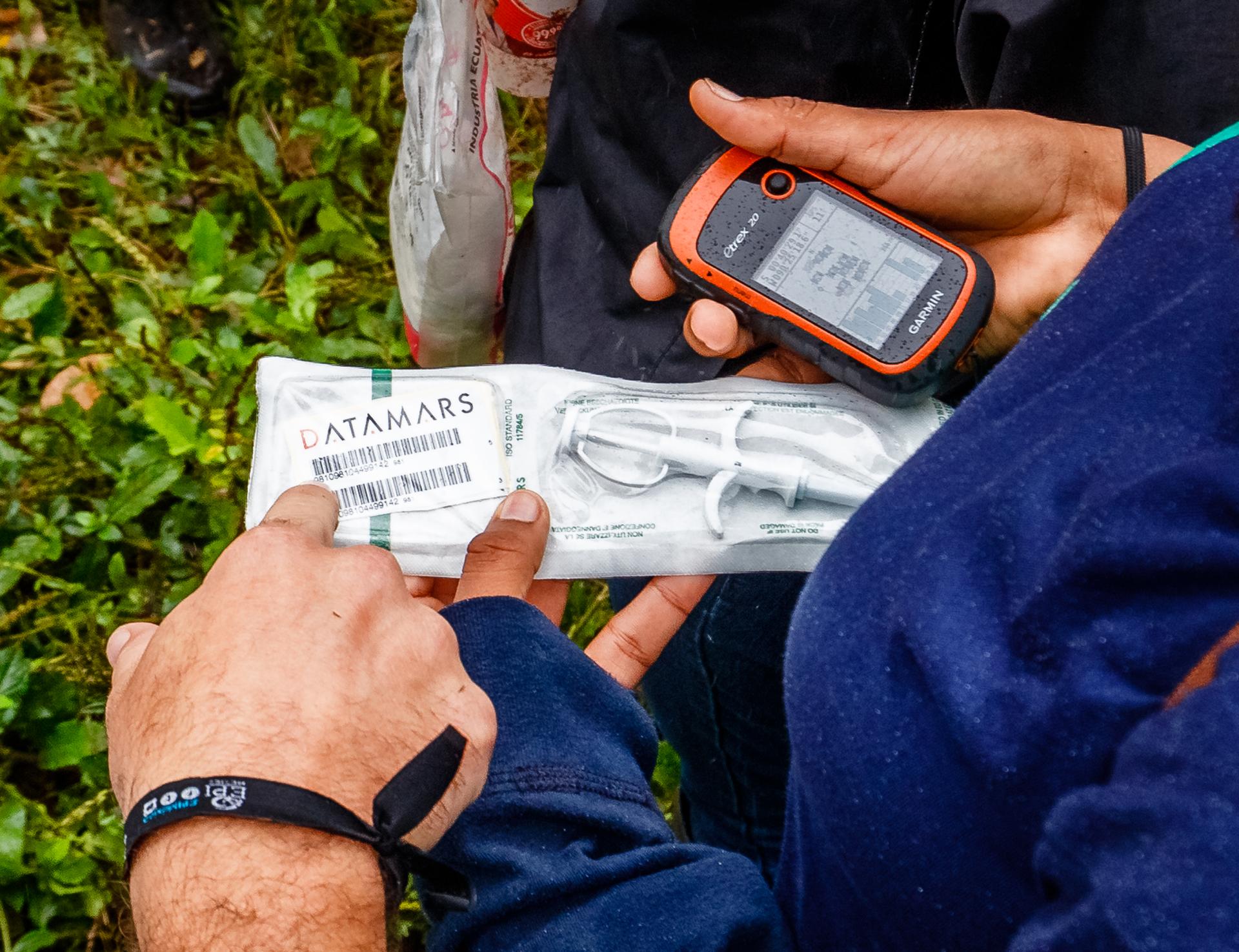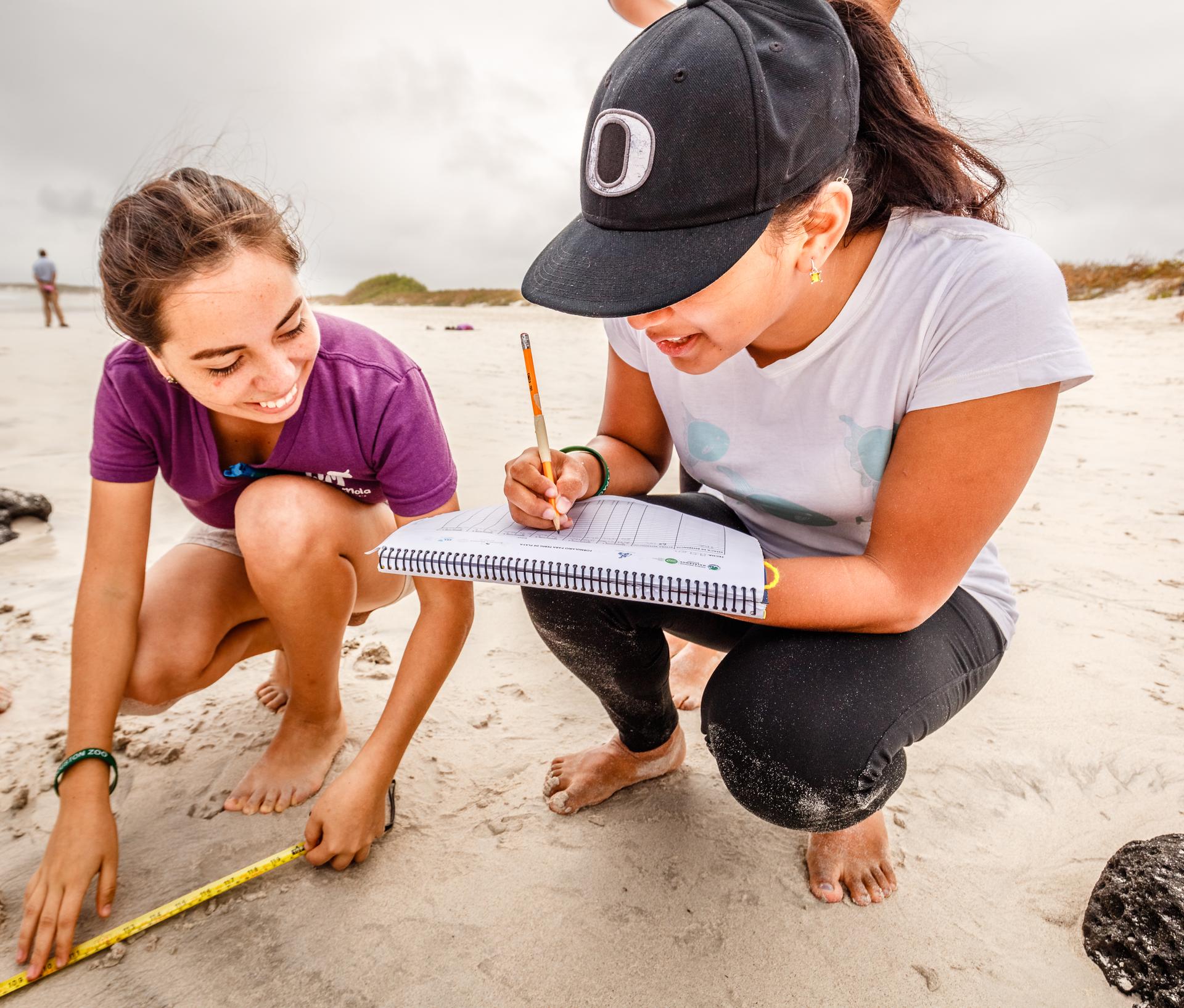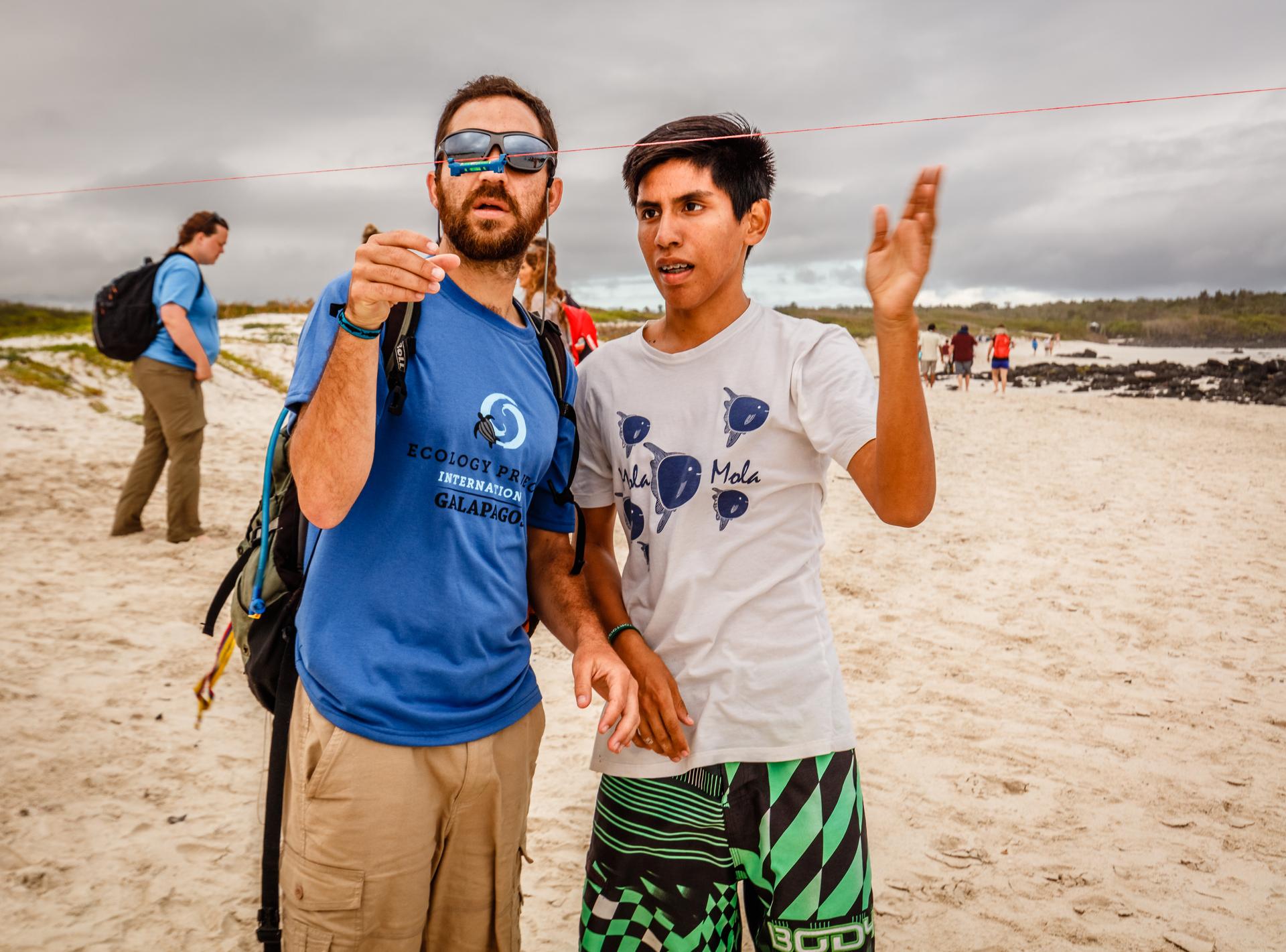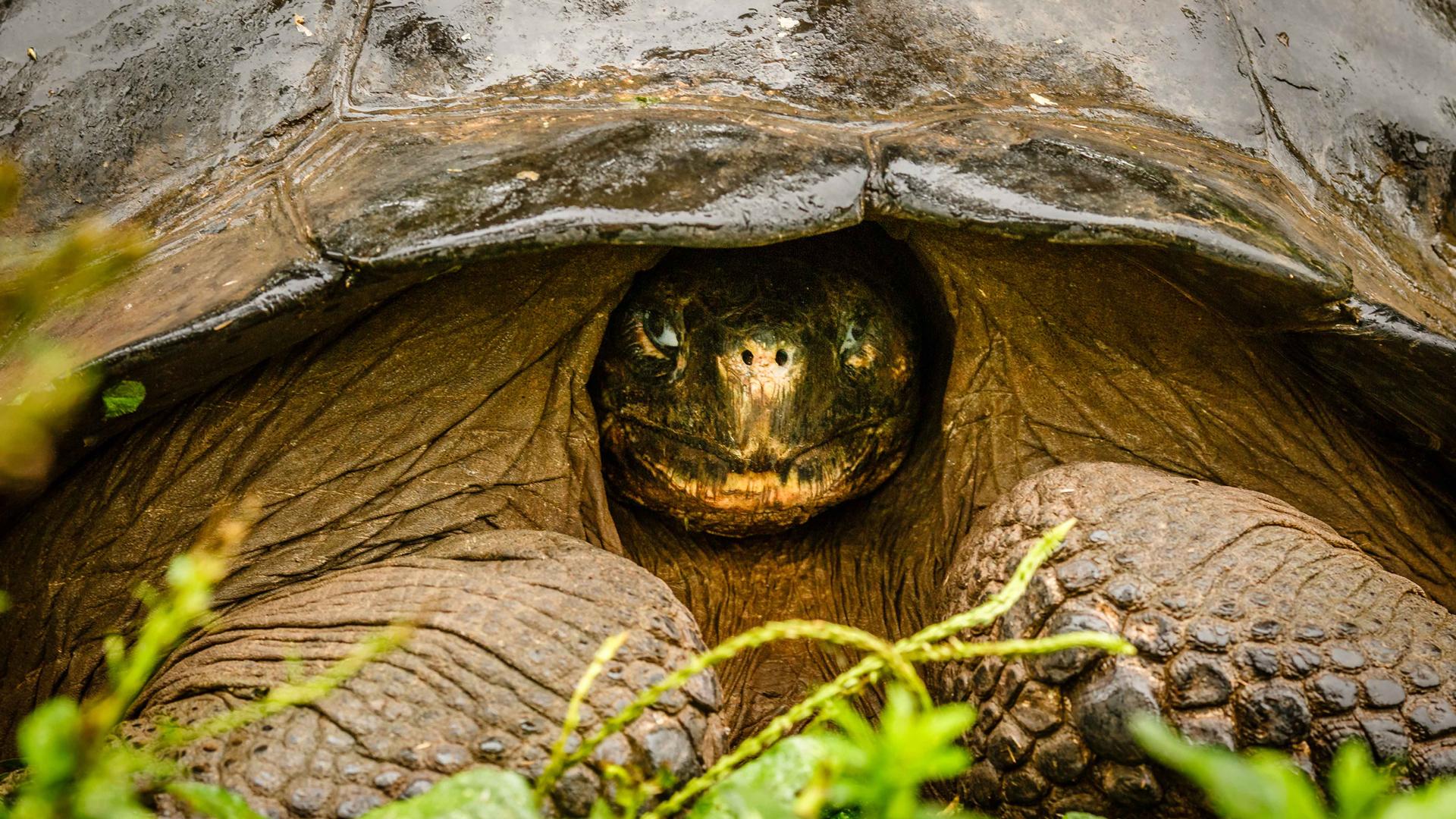These kids are hoping to save Galapagos tortoises — and their own home — from climate change
A giant land tortoise in the Santa Cruz highlands of the Galápagos Islands. National Park experts worry that due to weather extremes the food source for these tortoises is threatened.
The teens are huddled, hushed, peering at a motionless giant tortoise that lies at their feet. Is it alive?
The tortoise’s shell glistens, but it doesn’t move. No one dares to talk. And then, ever so slowly, the huge creature begins to lift its scaley, elongated head, and exhales — an incongruously loud gushing sound — and the students squeal with relief and shock. They’ve found their first tortoise, it’s time to get to work.
The students are from Cazares High School on the Galapagos Island of Santa Cruz. As part of their studies they are working with the Galapagos National Park and an NGO, Ecology Project International (EPI), to collect data on the land tortoise population of the Santa Cruz highlands.

It’s part of a program that is embedded in the Galapagos school system to involve youth in the critical environmental conservation work that is most often the terrain of adults. EPI trainers, María Fernanda Sevallos and Andres Holguín, have spent two days with the teens up in a highland camp building their knowledge base about tortoise ecology and its importance to the Galapagos Islands.
Now it’s time to meet the creatures and begin the work of finding, tracking and counting them. Careful notes are being taken at every step. Is the tortoise male or female, does it already have a little implanted tracking chip, what are its measurements and its weight?
It’s not work for the faint of heart, nor does the GNP allow anyone except its own people to actually touch a tortoise. But the Cazares students are with a national park ranger who is overseeing and helping with every step of the process.
“We're going to pass our data onto the scientists and they will analyze it,” Sevallos tells the students.
As Sevallos goes over the procedures that will need to occur with each tortoise they find, she reiterated that it’s no academic exercise. The students' careful tortoise work will produce important data, she said.
“But why is it important to study the ecology of giant tortoises?” Holguín asked the students?
“So they don’t become extinct,” answers 16-year-old Sisi Sanchez.
And while there are lots of threats to the giant Galapagos tortoise species, the changing climate is a big one, she said.
“Last year was a terrible catastrophe,” she said. “There was a drought, and all the grass dried up. Tortoises and also cattle had nothing to eat.”
Galapagos National Park ranger, Roberto Jimenez, said Sanchez is right. “The fields have been so dry, it was almost a whole year without food for the tortoises. We couldn’t find ways to get food to tortoises, and they lost a lot of weight.”
Some even died, he said. There have been periods with no rain before, Jimenez said, but he can’t remember a drought as long as last year’s dragged on.
Related: Humans are damaging the fragile Galapagos ecosystem. Maybe coffee can help save it.
The Galapagos Islands are showing signs of climate change impact. The fragile ecosystems have always been susceptible to environmental damage. The study of climate change impact has become a priority for the renowned Charles Darwin Foundation and the national park system.

The Ecuadorian school system is also taking action. In collaboration with EPI, they implemented educational programs to help build the next generation of eco-aware, climate educated citizens. It happens in the classroom and out in the various terrains of the enchanted islands.
On this winter morning, it’s chilly up in the highlands. The students have hold of a tortoise leg trying to ascertain if there is a tiny chip in the creature. The machine that can sense a chip beeps, which means there is no little chip in this tortoise. It’s the first time this majestic creature has been found during a process like this. So the students, under the careful watch of a national park ranger, will implant a chip.
The course Holguín and Sevallos are leading lasts four days. The students camp out, study in makeshift tents and get up close with the tortoises they are there to study. One unit involves digging through tortoise poop to determine what the tortoises are eating.
“These kids are amazing,” said Holguín as he watched a student summons the courage to stab the foot of the tortoise, piercing its thick skin with a device that implants the tracking chip.
Holguin has led classes like this for EPI in the Galápagos for years. “They come here, they learn about so many threats to the environment and then at the end of the course, they are choosing different things and they have this change in behavior, in attitude,” he said. “It gives me hope.”
It’s a real natural-world adventure slash education. But does their eco-consciousness last back in the real world?
A couple weeks later I visited the students at school — they were all formally dressed in their tunics, yet like teenagers anywhere, they joked loudly, flirted with each other. They seemed so different from the serious teenagers out in the forest with the tortoises.
In class, things got more focused. Science teacher Martha Criollo launched right into the unit they were doing on global warming. The students were working on projects about climate change and were one week into a project on gases like CO2. They used vinegar, baking soda and balloons to see how chemical reactions can produce gases. After six days the balloons had inflated.
“Why has the balloon inflated?” Criollo asked the students?
It’s the gases, one student said. “The gases are trapped.”
It’s an aha moment for the students. Criollo makes the link to greenhouse gases, and what can happen when they escape into the atmosphere.
At recess, the students grab a snack and meet near some bleachers to plot. Sisi Sanchez, 16, tells her friends that to get the authorities to take them seriously they should become an official club, and maybe do a campaign to get rid of plastics. Plastic bottles and bags end up everywhere, she said. When they were in the highlands they saw fragments in the tortoise poop — a clear sign, Sanchez said, that tortoises are eating plastic.
Another student said they should also try to get the national park and the Charles Darwin Foundation to support them. It’s not a far-fetched idea. Students here have regular contact with Galapagos National Park officials.
Jonathan Romero runs the park’s educational programs on the island of Isabela. “One of the principal themes that we have begun working on is climate change,” Romero said.
They start young. Four and 5-year-olds get basic climate education too, Romero said. Park educators take students up to the highlands and even out to the volcanoes to see the how the landscape has changed. Students love it, Romero said. It’s definitely way cooler than sitting at a desk all day.
The embedded eco-education really does seem to be taking hold. While the EPI students tracking tortoises up in the highlands were just at the start of their practical education, down at the main beach of Santa Cruz Island, Tortuga Bay, another group of teens are working on individual projects — marine turtle egg monitoring, tracking plastics in the ocean, and even a sand erosion analysis.

These youth are part of an environmental club housed at Ecology Project International. To do their bi-monthly monitoring work the students make a 45-minute hike out to Tortuga Bay. They carry all their implements in backpacks and get to work right away. No bikinis and beachballs for these kids.
Related: Is tourism harming the Galápagos Islands?
On a windy winter afternoon, 17-year-old Camila Leon is on her tippy toes trying to tie a piece of string to a pole wedged into the sand. She’s midway through a year-long study of beach erosion.
Leon has her nylon string, her measuring tape. Her methodology was learned under the guidance of EPI trainers and national park experts. They stick a pole in the sand, tie a string to it and take it up the beach to the sand dune and then measure.
Helping her is Albert Proaño, a GNP marine technician who has been doing this sand level analysis for years. Mostly for one main reason, he said. “Turtle nests are laid here, and we want to see how they are affected,” he said.
If there is less sand ,the marine turtles can’t bury their eggs. And fewer eggs over time can be a straight line to extinction.
Climate change is causing sea levels to rise and making storms more intense. That means more coastal erosion worldwide. And maybe even right here, at Tortuga Bay.

“Well its normal that the sand levels change, but these last few years the changes have been really abrupt,” Proaño said.
In previous decades, natural cycles took away sand and brought it back, but these last few years it has just been decreasing, he said.
Leon noted a change in the level of the sand at the dune on this particular measurement day. Her careful notes will be entered into database, which will add to the measurements the national park technicians are taking to help understand what’s going on on this beach.
And after six months of collecting data here, Leon is pretty sure she sees a trend.
“I think the beach is eroding,” she said.
It can’t be easy to see this, especially for someone so young, who grew up on these islands. But Leon says she plans to keep working on the beach project because the creatures are worth it.
“I’ve always been fascinated by these animals because they have survived so long through the ages,“ Leon said. “But [now] there’s just a lot less of them, as everyone knows they’re in danger of extinction.”
Leon knows that she and her schoolmates didn’t cause the climate change that’s threatening the turtles’ habitat. But she's serious about wanting to fight its impacts and be part of a solution.
It’s a determination that’s taking hold among other young people here on one of nature’s most spectacular creations.
The reporting for this story was supported by the Atlas Family Foundation.
Our coverage reaches millions each week, but only a small fraction of listeners contribute to sustain our program. We still need 224 more people to donate $100 or $10/monthly to unlock our $67,000 match. Will you help us get there today?
